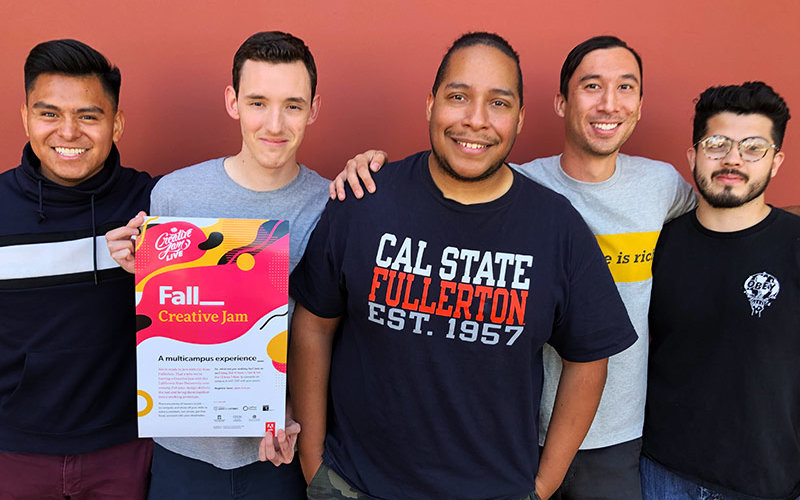
Five Titan art students displayed strong creative ingenuity and top-notch technical skills to finish in fourth place in a two-day Adobe Creative Jam held last month at Cal State Fullerton.
Team CSUF 2019 – composed of Michael Aldama, Baltazar Resendiz, Eli Hebert, Ricky Acevedo and Octavio Garcia, was one of 59 teams tasked with developing an application that would help students experiencing homelessness, mental health issues and food insecurity.
“The Adobe Creative Jam is a series of competitions held across the country. In our case, it was a head-to-head competition with seven other Cal State University campuses on UI/UX (user interface/user experience) design,” explained John Drew, CSUF professor of art who served on the CSU event planning committee. “This was a high-impact, service-learning experience that exposed students to issues that most were not aware of, and to address it under a tight deadline.”
In the first go-round, teams had two hours to learn the subject of the application and present a concept before judges. “The nature of the competition was kept a secret until we were all online watching Adobe’s live stream of the event,” said Michael Aldama, senior BFA art-graphic and interactive design major.
“Our app concept focused on mental health by creating a support network of resources, on- and off-campus, for students who may not have that,” explained fellow BFA art senior Eli Hebert. “Students who are feeling down or going through rough times tend to isolate themselves from reaching out to others, and will tend to not be proactive in searching for help. To address this, we created an idea for an artificial intelligence chat-bot that students could send messages to, and the bot would respond with resource links either to on-campus locations, or to resources in the immediate community.
“The app was named ‘Emma’ as an acronym from our keywords ‘Empowering, Meaningful, Motivational, Awareness’,” Hebert added. “This would help connect the various support networks, groups and resources (especially on-campus) to a student who is at risk or in need. At the very least, it would help raise awareness of the various programs supporting students.”
Afterward the first phase of the competition, CSUF 2019 “had a good feeling that we made a strong impression and we had a good chance at making it to the finals,” noted Hebert. “When we heard our team name called, it was a weight off our shoulders, but we had to immediately go back into preparation mode for the next step of the jam.”
Semifinalists worked through the night to further their concepts and presentations before again facing the judges.
“Competing against the other teams was inspiring, mainly to see how we stacked up in terms of design capabilities and how fast we were able to create a working prototype,” said Aldama. “Going from a sketch on paper to a pitch in a boardroom, I’ve learned that when it comes down to the wire, I know I’ll be able to perform.”
As a team, we “all learned how to collaborate on a given topic, conduct quality research in a short amount of time, collectively come to a decision, and make sure everyone is on the same page,” he added.
“Overall, although stressful, it was a fun experience!” Hebert said. “I’d recommend it for our design students. It’s a great opportunity to learn about your workflow, how you work under pressure, and how you communicate with your team.”